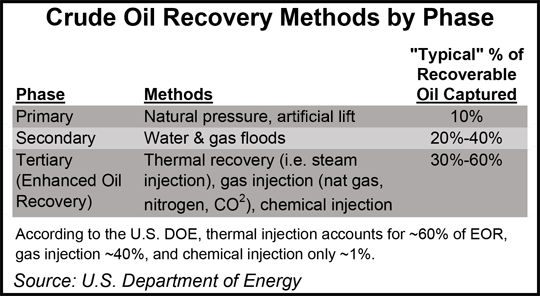Chu Tapped to Help Start-up with EOR Efforts
Former U.S. Secretary of Energy Steven Chu has joined the board of a fledgling Canadian company looking to break into the U.S energy market with a carbon capture technology it claims has the ability to boost enhanced oil recovery (EOR) in basins across the country.

British Columbia-based Inventys Thermal Technologies courted Chu, who served as the Department of Energy’s secretary from 2009 to April of this year, through an investor as it made trips to market and discuss its new technology with policy officials and others in the U.S., said CEO Andre Boulet.
“It’s unfortunate that there’s really no standing policy that drives the carbon market; we recognize that enhanced oil recovery is something we could really focus on with this technology and go after,” Boulet told NGI’s Shale Daily. “There’s a long, long history of using carbon to get more oil out of the ground in places like Texas and we want to help keep that moving.
“Dr. Chu has been in thousands of situations at the DOE that can really help us navigate the energy policy landscape in the U.S. and help a company like ours understand the business and how to take our marketing and operations to another level there,” Boulet added.
Inventys has patented a system called VeloxoTherm, which it is currently in the early stages of marketing, that uses significantly less energy to capture flue gases from coal and natural gas power plants.
With low capital costs compared to other systems on the market, Inventys says its system can capture carbon dioxide at a cost of about $15 per ton. Although it doesn’t manufacture the system’s hardware, Inventys will finance and operate carbon capture facilities or retrofit existing flues with VeloxoTherm and sell the carbon for enhanced oil recovery or underground sequestration.
“The U.S. has pioneered EOR because there’s a great opportunity to get more oil out of the ground, but there’s only a handful of natural carbon deposits — they’re very rare,” Boulet said. “The market is supply constrained and that’s where we come in. Operators have an insatiable appetite for additional carbon and the technology is growing with horizontal drilling, there’s a huge opportunity out there right now, and as the technology improves, it could lead to billions, even trillions of barrels of additional oil.”
Enhanced oil recovery is nothing new. Conventional drilling often leaves behind 75% of recoverable oil and gas and EOR has been used since the 1970s, when it was first employed in the Permian Basin where heavy oil, poor permeability and irregular faultlines meant the properties of the hydrocarbons would need to be changed.
Waterflooding and gas injection were used during secondary recovery to push oil through the well, but EOR essentially restores the formation’s pressure and increases the mobility of the reservoir when the gas mixes with the oil and decreases its viscosity making it flow more easily.
The DOE estimates that EOR could mean an additional 60 billion barrels of oil, but the number could grow as operators in oilfields such as the Bakken continue to tinker with its applications in horizontal drilling. Costs remain a hurdle and Inventys believes its low-cost technology will help operators to make more headway.
“Oil companies don’t care about how carbon is captured, they simply want low costs because EOR is very expensive,” Boulet said. “We can give that to them. Our product is about a fifth of the cost of other competitors. We can still make a healthy profit and they can leverage a low price.”
The VeloxoTherm system employs a slowly rotating structure that holds a proprietary material that traps carbon when it is cool and releases it when it is hot. Flue gas passes through the material and the carbon is captured.
Boulet said Chu understood the system more quickly than most. A long-time advocate of renewable energy technologies and an early supporter of horizontal hydraulic fracturing, Chu is currently a professor of physics and molecular and cellular physiology at Stanford University.
At a recent oil and gas conference in Cleveland, Paul Dudenas, manager of engineering at Pennsylvania-based East Management Services LP said that the Appalachian Basin has historically provided about 1% of all U.S. oil production. But during a presentation, Dudenas discussed the benefits of EOR and said that as older conventional oilfields in Ohio, West Virginia and Pennsylvania are revived using the method, and as horizontal drillers increase the use of enhanced techniques as time goes on, the formations will ultimately produce even more oil in the future.
The DOE is currently undertaking research and development efforts that could significantly improve the economic performance and expand the applicability of carbon injection to a broader group of reservoirs in basins closer to major sources of man-made carbon dioxide.
© 2024 Natural Gas Intelligence. All rights reserved.
ISSN © 2577-9877 | ISSN © 2158-8023 |
